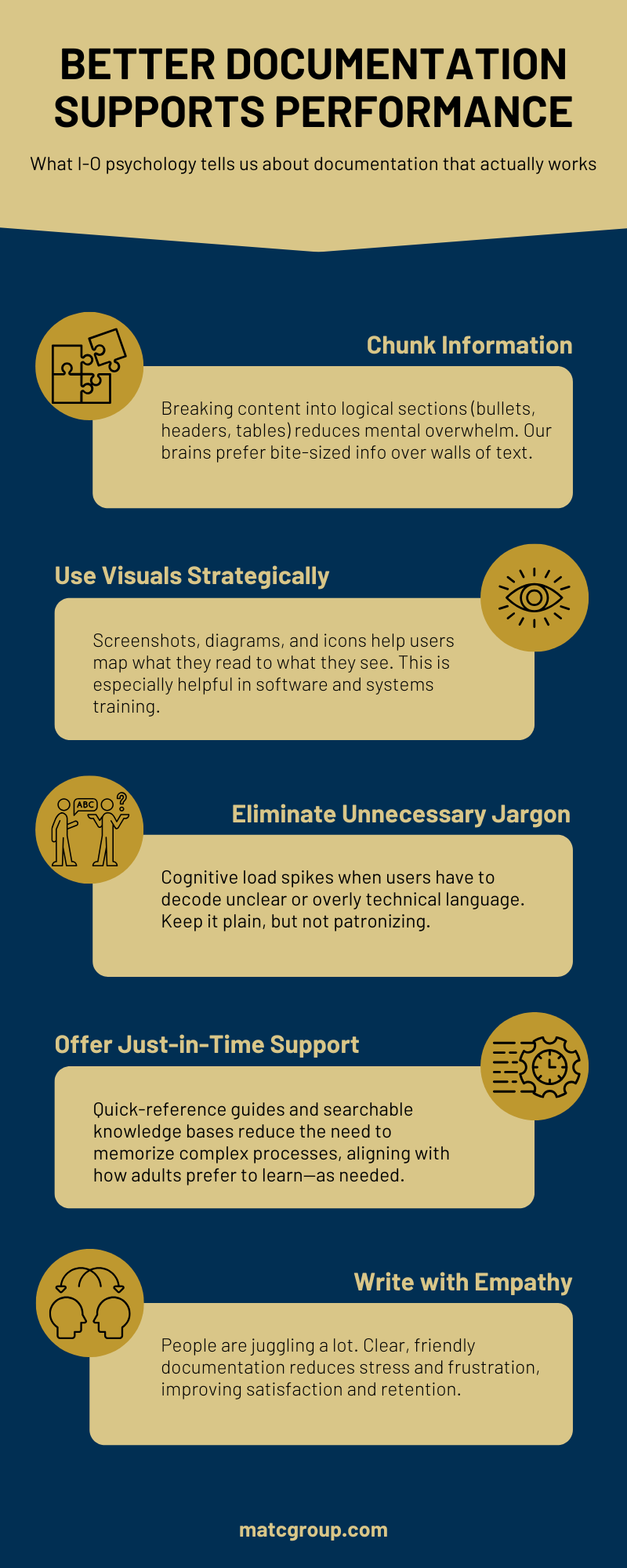- +1 (267) 368-7090
- contact@matcgroup.com
-
53 Knightsbridge Rd,
STE 216
Piscataway, NJ 08854.
Let’s face it—no one wants to read a 47-page manual to figure out how to reset a password. And in a fast-paced workplace, overly complex documentation is both annoying and costly. It slows people down, increases errors, and leads to more help desk tickets from frustrated people (sorry, IT).
That’s where Industrial-Organizational (I-O) Psychology comes in. This field helps us understand how humans think, learn, and perform at work. It also has a lot to say about the way we write documentation.
By applying lessons from I-O psychology, we can design documentation that reduces cognitive load, boosts employee satisfaction, and actually helps people do their jobs better.
Industrial-Organizational Psychology is the science of human behavior in the workplace. It combines elements of psychology, business, and data analysis to improve everything from hiring to leadership to training and documentation.
I-O psychologists ask questions like:
They’re especially interested in something called cognitive load, the mental effort required to complete a task. And that’s where technical documentation plays a starring role.
Cognitive load isn’t just academic jargon. It’s real. If you’ve ever had 12 browser tabs open trying to figure out one process, you’ve felt it.
There are three types:
The goal of good documentation? Minimize extraneous load, manage intrinsic complexity, and support germane load so users can focus on the task, not deciphering your instructions.
Great documentation is more than looking polished. It reduces mental strain so people can focus on getting work done. These strategies from I-O psychology show how the right kind of support boosts performance, satisfaction, and retention.

According to I-O psychology, employee performance is about environment as much as skill. When documentation is confusing or incomplete:
But when documentation is clear, concise, and cognitively considerate, people feel more capable and supported. That’s a big win for culture and productivity.
Technical writing is about cognitive design as much as it’s about compliance. When we reduce unnecessary mental effort, we make life easier for employees, improve performance, reduce burnout, and create a better workplace.
So, the next time you update that user guide or knowledge base article, ask yourself:
Because the easier it is to be right, the less time we all spend fixing what went wrong.
Embedding Company Values into Training and Documentation: Why It Matters
Best Practices for Effective and Engaging Communication in the Workplace
From Good to Great: Elevating Instructional Design Beyond the Basics
“Cognitive Load Theory : A Guide to Applying Cognitive Load Theory to Your Teaching.” Medical College of Wisconsin. May 2022. Accessed 8/4/2025. https://www.mcw.edu/-/media/MCW/Education/Academic-Affairs/OEI/Faculty-Quick-Guides/Cognitive-Load-Theory.pdf